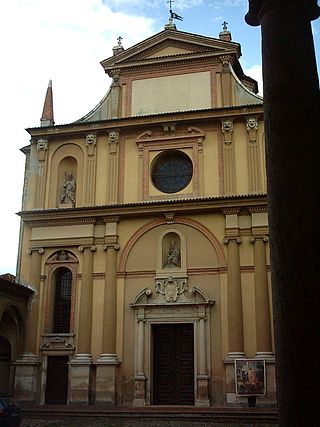Santa Teresa del Carmelo is a seventeenth-century Roman Catholic Baroque-style church located on Corso Vittorio Emanuele II #161 in Piacenza, Italy.

San Giovanni in Canale is a Gothic-style Roman Catholic church located on Via Croce #26 in central Piacenza, formerly associated with a Dominican monastery.

The church of San Paolo is a Roman Catholic church, located in Piacenza, Italy. Mentioned as the site of a parish church by 887, the present structure was built at the end of the seventeenth century.
Bartolomeo Baderna (1655-1681) was an Italian painter and engraver of the Baroque period.
Sant'Eufemia is a Roman Catholic church located at the corner of the homonymous via and Via Boselli-Bonini in Piacenza, region of Emilia Romagna, Italy.
San Pietro is a Roman Catholic church in central Piacenza, Emilia Romagna, Italy. The church was built over the site of an ancient church titled San Pietro in Foro.

San Donnino or San Donnino Martire is a Romanesque style Catholic church located at the intersection of Largo Cesare Battisti and Vicolo San Donnino in the historic center of Piacenza, Region of Emilia Romagna, Italy. Little is known of San Donnino, to whom the church is dedicated, as are other churches elsewhere, including Pisa. A St Domninus appears in early Church sources and some identify him with St Domninus of Fidenza, to whom Fidenza Cathedral is also dedicated. For some the Piacenza Domninus was a deacon of Piacenza in the early Christian period.

Sant'Agostino is a Renaissance style, former Roman Catholic church, located at the intersection of the Avenue Farnese and via Giordani in Piacenza, region of Emilia Romagna, Italy.

San Sisto is a Renaissance style, Roman Catholic church, located on the Via of the same name in north-central Piacenza, Region of Emilia Romagna, Italy.
The following is a timeline of the history of the city of Piacenza in the Emilia-Romagna region of Italy.

Santa Brigida is a Neo-Gothic style, Roman Catholic parish church, located at Via del Castello #2, corner with Piazza del Borgo, in Piacenza, Region of Emilia Romagna, Italy.

Palazzo del Governatore is a neoclassic-style palace located facing Piazza dei Cavalli in the historic center of Piacenza, northern Italy which now houses the town's chamber of commerce. The facade is flanked by two bronze equestrian statues sculpted by Francesco Mochi and depicting the Farnese Dukes of Parma: Ranuccio (1612–20) and his father, Alexander (1620-1629). Across the piazza is the Gothic-style Palazzo Comunale and the two equestrian statues of Farnese dukes, Alessandro and Ranuccio.

San Bartolomeo is a Baroque-style Roman Catholic church, now deconsecrated, located on 48 Via San Bartolomeo in the city of Piacenza in Italy.

San Vincenzo is a Baroque style, Roman Catholic church, now deconsecrated, located at Via Scalabrini #6 in the South-East quadrant of Piacenza, Region of Emilia Romagna, Italy. The church was restored starting in 2009 for use as an auditorium and to host concerts.
Santa Raimondo is a Baroque style, Roman Catholic church, attached to a functioning Benedictine order cloistered monastery occupied by San Raimondo nuns. It is located at Corso Vittorio Emanuele #154 in the southern edge of historic Piacenza, Region of Emilia Romagna, Italy.
The Oratory of San Cristoforo is a deconsecrated former Roman Catholic church or chapel located at the chamfered corner of Vie Gregorio X and Angelo Genocchi, in the north-central sector of the historic center of Piacenza, Italy. It rises a block North West of the former Chiesa Sacro Cuore (Gesu) erected by the Jesuits and now housing the Teatro Gioia. The oratory presently houses an exposition space and museum named the Piccolo Museo della Poesia.

The Teatro Municipale or Municipal Theater of Piacenza is the main Neoclassical-style opera house in the city, located on Via Verdi #41, facing Piazza Sant'Antonino and flanking the Palazzo Anguissola di Cimafava Rocca in Piacenza, Italy.
San Giorgio in Sopramuro is a Baroque style, Roman Catholic oratory, located at via Sopramuro #61, in Piacenza, Region of Emilia Romagna, Italy. The church is also called San Giorgino to distinguish the temple from the church of San Giorgio in via Calzolai.
Santa Margherita is a Baroque style, now deconsecrated Roman Catholic church, located at Vicolo Santa Margherita #9, in Piacenza, Region of Emilia Romagna, Italy. The church since 1992 is used as an auditorium for cultural events by the Fondazione di Piacenza e Vigevano.
San Maria in Gariverto is a Neoclassic style, Roman Catholic parish church, located on Via Genocchi #33, in Piacenza, Region of Emilia Romagna, Italy.












